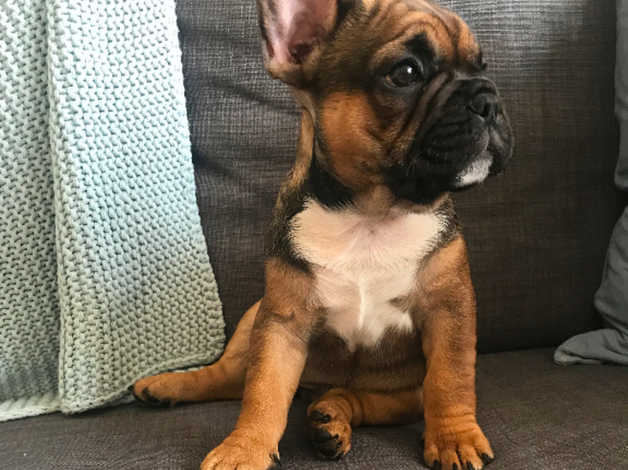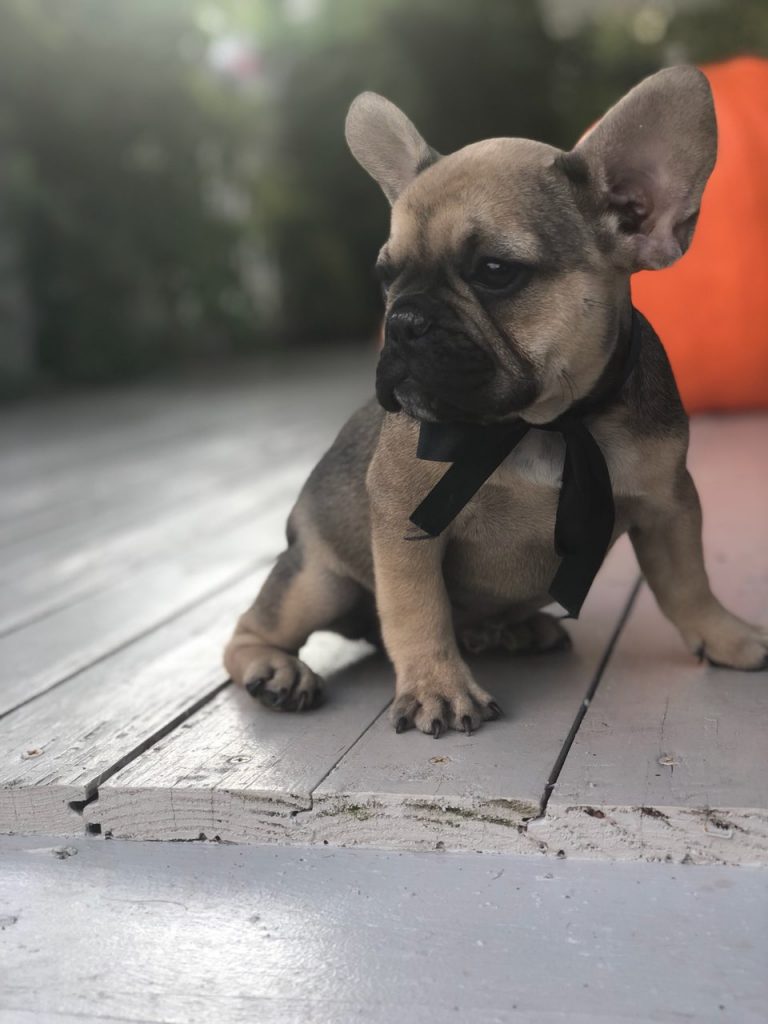Stunning Sable Frenchies: The Rare Breed with a Beautiful Fawn Coloring
Do you love the look of a sable Frenchie? If so, you’re not alone. These beautiful dogs are pretty rare, and they have a unique coloring that is sure to turn heads. This article will discuss everything you need to know about sable Frenchies. We’ll talk about their history, personality traits, and why they make such great pets. We’ll also provide some pictures of these stunning dogs to see for yourself just how beautiful they are!
Sable Frenchies have a basic fawn coloring (from a light tan to a darker reddish coloring) with a blending of black and black-tipped hairs, most prominent on the back, sides, and head. These are fairly rare and very striking dogs. There has been an increase in sable Frenchies due to their popularity as show dogs, but they remain uncommon.
Sable Frenchies have black hairs or dark tips sprinkled throughout their heads and bodies. Unlike spots or patches, the black hair on these Frenchies is distributed equally and blended with fawn fur, giving them a distinct appearance.
The Sable French Bulldog Breed’s DNA
Sable Frenchies are a mix of fawn and tricolor. All of these hues are represented by the “A” locus. Loci is a scientific term that refers to the position on the DNA strand. The sable gene is dominant, meaning that it only takes one copy of the gene to produce a sable French Bulldog.
The genes also cause the black and tan markings on sables at the “A” locus. The “a” allele produces solid black hair, while the “at” allele produces a black and tan dog. Dogs that are sable and have the “at” allele will have more black hairs throughout their coat.
The A locus can have four alleles, and each allele results in particular coat colors. These alleles are a, at, aw, and ay.
How Rare Are They?
The Sable/fawn gene is not uncommon, but you’d have difficulty locating Sable Frenchies. Breeders still don’t completely understand their genetic makeup, and most of the time producing Sable Frenchies is a roll of the dice.
With only about 25% of the litter being sable, they are quite rare.
The Sable French Bulldog’s Physical Appearance
A Sable Frenchie looks exactly like a regular Frenchie, except for its coat and color. They have tiny, athletic bodies, flat muzzles, conventional bulldog jowls, and bat-like ears that are distinctive to them.
Sizing Sable Frenchie Puppies
When purchasing a sable French bulldog puppy, it is important to remember that they will not stay this small forever. Like all puppies, they will grow into their adult size. A sable Frenchie puppy should weigh between 10 and 15 pounds at eight weeks old.
The sable French Bulldog is smaller than the average Frenchie, but they are still a robust breed. Most sable Frenchies weigh between 18 and 25 pounds. Because of their small size, they are perfect for city living.
The Temperament of Sable Frenchies
The temperament of a French sable bulldog is just like any other Frenchie. They are loving, playful, and make great family pets. They are perfect for city living because of their small size and low-maintenance coat.
They are also great with children and other pets. They make the perfect addition to any family with their gentle and loving temperament.
Colors of the French Bulldog’s Sable Coat
The unusual coat of a Sable-colored French Bulldog is his striking coat. The fawn or reddish fawn base coat of Sable Frenchies is littered with black hair. The density of the black hairs increases toward the back (top of the back, neck, and head).
We mentioned that the Sable color French Bulldog has a fawn coat, so what’s the difference between fawn and sable? Some people believe that French Bulldogs with black masks are fawn, but we also have French sable bulldogs.
Technically, a sable is a coat pattern that refers to any dog with hairs of two or more colors. So, a fawn Frenchie can be called a sable if it has black hair sprinkled throughout its coat.
Blue Sable Frenchies

Like any other sable French Bulldogs, they are just like any other sable French Bulldogs, except their coat is blue instead of fawn. The blue color is caused by the “D” locus, which is responsible for the production of blue pigment. Sable French Bulldogs with the “D” allele will have a blue coat.
Blue sables are quite rare, and because there is not much information about them, they are still somewhat of a mystery to breeders. They are beautiful dogs, and their unique coat pattern makes them stand out from the rest.
Red Sable Frenchies

Just like blue sables, red sables result from the “D” locus. They have a predominantly red coat, with black hairs sprinkled throughout.
Red sables are also quite rare, and there is not much information about them available to breeders. They are attractive dogs, and their unique coat pattern makes them stand out from the rest.
Lilac Sable Frenchies

They have a purple tint with lilac markings on their nose and mouth.
Chocolate Sable Frenchies

They have a predominantly chocolate coat, with black hairs sprinkled throughout.
Sable Pied Frenchies

They are a rare breed of Frenchie with an absolutely beautiful fawn coloring. They are often mistaken for black and white French Bulldogs, but their sable coloring is unmistakable.
Sable pieds can come in any combination of colors, but they always have a fawn base color with markings on their head, chest, and legs. They are one of the most unique and stunning Frenchie variants available, and they are sure to turn heads wherever they go.
Frequently Asked Questions
How sable can Frenchie coloring change with age?
The sable Frenchie’s coloring can change somewhat as they age, with the black tipping on their fur becoming more pronounced.
What are the health concerns for sable Frenchie?
A few health concerns that sable Frenchie owners should be aware of. Some of the most common health problems include hip dysplasia, patellar luxation, and allergies.
Sable French Bulldogs are also prone to heatstroke, so they should not be left outside in hot weather for extended periods. Owners should also ensure they provide plenty of shade and water when the weather is warm.
Are sable Frenchies hypoallergenic?
No, Sable Frenchies are not hypoallergenic. People sensitive to dogs may develop allergic responses to their saliva, shedding, and dander.
Do sable Frenchies shed a lot?
Sable Frenchies are prone to shedding, so owners should prepare their homes to be covered in dog hair during the spring and fall months.
How much do French sable bulldogs cost?
The typical cost of a Sable French bulldog ranges from $4,000 to $10,000, with prices increasing or decreasing depending on the breeder and coat color.
The price of a blue Sable French bulldog will be greater than that of a black sibling one. The cost of the pink Sable French bulldog is rather.
Are there any sable french bulldog breeders?
There are many Sable French Bulldog breeders throughout the country, but it is important to do your research before choosing one.
When buying a pup, ask for the complete medical records. Avoid buying from breeders who keep their puppies in noisy, dirty, and overcrowded areas. You should also avoid puppy mills and pet shops.
How long do sable Frenchies live for?
Sable Frenchies typically live for about 12-14 years.
Are sable Frenchies good with kids?
Yes, sable Frenchies are good with kids. They are playful and gentle, and they love spending time with their human family members. However, it is important to remember that all dogs should be supervised around small children to prevent any accidents from happening.
Final Words
Sable French Bulldogs are a unique and beautiful breed of dog that comes in various colors, including red, chocolate, and lilac. They are prone to shedding and may require some extra care due to their sensitive skin, but they make excellent pets for families with children. Sable Frenchie owners should be prepared for these dogs to live for around 12-14 years. Thanks for reading!
